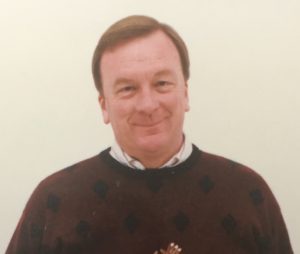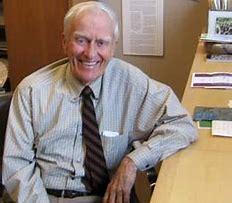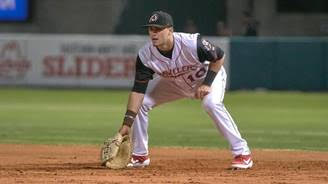
By Bill Knudsen

Ron Fairly died at 2:13 AM on Oct. 30. He had been fighting prostate cancer but was in remission at the time of his death. Ron actually died from the radiation, which harmed his body. He played over 20 years in The Show, was involved with the game for over 50 years, as a player and broadcaster. And was Dave Niehaus’s drinking buddy, caddy and fellow Mariner broadcaster from 1993-2006. He was a superb storyteller and could always make Dave (and Rick Rizzs) laugh.
At a party once I heard my old boss, Gene Autry, tell Niehaus that “he broadcasts a really good game. It wasn’t necessarily the game I’m watching, but you call a good game.” In other words, as he got older, sometimes he would miss-call a play or two. He would call it a home run, when in fact, the ball was caught on the warning track. Ron sometime suffered from that same malady. But we over-looked those calls because the 50+ years of baseball stories in between were priceless.
Ron and David (together) were world-class, old-time baseball guys who had decades of history and stories to share. And if you were ever lucky enough to sit behind them on one those long plane rides home from an East Coast swing, while they went cocktail for cocktail in First Class…well…let’s just say it was an “R” rated hoot! He and I recently became email buddies, and I’ll miss him. “Red” was 81 and he left three sons behind.
——————————————
RIP JIM—10/21/19
 Some people like to talk about change: James R. Ellis made it happen, shaping Seattle and King County more than any person from the 1950s past the dawn of the 21st century.
Some people like to talk about change: James R. Ellis made it happen, shaping Seattle and King County more than any person from the 1950s past the dawn of the 21st century.
Ellis, the “Father of Metro”, architect of the Lake Washington cleanup, mastermind of Freeway Park and the Seattle Convention Center, died Oct. 21 at the age of 98.
“He never served in elective office but mightily shaped this region and so much of what we treasure about this special place we call home,” King County Assessor John Arthur Wilson wrote on his Facebook page. “If you marvel at Lake Washington on a sparkling Summer day, or hopped a Metro bus today, take a moment to thank Jim Ellis.”
No two brothers in our city’s history accomplished more to make Seattle better than Jim and John Ellis. We truly are blessed to have had these two men in our community. And I am doubly blessed to have known them both. Thank God, John is still with us as the Chairman Emeritus of the Seattle Mariners.
——————

OK, were committed to rebuilding the Mariners from the ground up. So, how did our top 15 prospects do in 2019? And what can we expect in 2020? Obviously, the rankings will change going into next season, based on how they performed last season. And there are certain to be additions and subtractions to this list moving forward.
1. Justus Sheffield, LHP
Where he started and finished in 2019: Started in Class AAA Tacoma’s rotation and finished in the Mariners rotation with a detour through Class AA Arkansas.
What went wrong: Sheffield’s time with the Rainiers was a disaster, posting a 6.87 ERA in 13 appearances. His command was inconsistent, his mistakes got crushed and his confidence took a hit.
What went right: Demoting Sheffield to Arkansas allowed him to reset. He was stellar in Arkansas (5-3, 2.19 ERA in 12 starts) and looked little more poised in seven starts (5.45 ERA) with Seattle to end the season.
Where he’ll start in 2020: Given his age, experience and expectations, Sheffield should be in the Mariners’ opening day rotation.
2. Jarred Kelenic, OF
Where he started and finished in 2019: Started with Low-A West Virginia, advanced High-A Modesto and finished with Arkansas.
What went wrong: He only made it three levels in one season? Not much went wrong for the outfield prodigy. He dealt with minor injuries and slumps, but that’s expected of any player.
What went right: The Mariners knew Kelenic had an advanced approach, particularly at the plate and in his daily preparation. He rocketed through the system, posting a combined .291/.364/.540 slash line (batting average, on-base percentage and slugging percentage) with 32 doubles, 23 homers, 68 RBI and 20 stolen bases.
Where he’ll start in 2020: Kelenic likely will return to Arkansas to start the season, but the hope is that he’ll play his way up to Tacoma by July and be ready for a late-season call-up.
3. Evan White, 1B
Where he started and finished in 2019: White spent the entire season with Arkansas. He didn’t receive a September call-up but spent the last week of the Mariners’ season in Seattle working out and going to team meetings.
What went wrong: White dealt with some minor injuries, a slow start due to leg issues and the unfriendly hitting confines of the Travelers’ home field.
What went right: He posted a .293/.350/.488 slash line with 13 doubles, two triples, 18 homers and 55 RBI in 92 games while still playing his stellar defense at first base. He continued to show improvement with his power numbers.
Where he’ll start in 2020: White will compete for the starting first base job in spring training, but he’ll likely begin the season with Tacoma and be called up by midseason.
4. Julio Rodriguez, OF
Where he started and finished in 2019: Went from West Virginia to Modesto and is currently playing in the Arizona Fall League.
What went wrong: Rodriguez broke his left hand after being hit by a fastball April 12, which kept him on the injured list until June 10.
What went right: When healthy, Rodriguez, 18, continued to show why scouts think he could be a future star. After 67 solid games with West Virginia (.293/.359/.490, 20 doubles, a triple, 10 homers, 50 RBI), he was promoted to Modesto late in the season and put up cartoon numbers in 17 games — .462/.514/.730 with six doubles, three triples, two homers and 19 RBI.
Where he’ll start in 2020: With a strong spring, he could start in Arkansas at 19 and be one of the youngest players in the Texas League.
5. Kyle Lewis, OF
Where he started and finished in 2019: After playing his first full minor league season with Arkansas, he ended 2019 as an everyday outfield starter in September for the Mariners.
What went wrong: Lewis’ average and power numbers to start the season weren’t great. He was victim of bad luck and a bad hitting park.
What went right: He stayed healthy for an entire season, something he hadn’t done since being drafted in the first round in 2016. He also hit six homers in his first 10 MLB games.
Where he’ll start in 2020: He should be the Mariners’ starting left fielder when they open the 2020 season.
6. Justin Dunn, RHP
Where he started and finished in 2019: Started as Arkansas’ No. 1 starter and finished the season in the Mariners rotation.
What went wrong: His MLB debut and next start were pitch-filled with overwhelming nerves, too many walks and plenty of runners. But they were blips in an otherwise strong season.
What went right: Dunn showed durability and command of his four-pitch repertoire, posting a 9-5 record with a 3.55 ERA in 25 starts, striking out 158 batters and 39 walks in 131 2/3 innings with Arkansas. He also looked more comfortable in his final starts with the Mariners.
Where he’ll start in 2020: Dunn will be given every opportunity to make the Mariners’ opening day rotation. If he doesn’t make it, he’ll likely start in Tacoma.
7. Logan Gilbert, RHP
Where he started and finished in 2019: Like Kelenic, he moved up three levels in one season, from West Virginia to Modesto to Arkansas.
What went wrong: Some fatigue in his final outing with Arkansas made the Mariners shut him down and not allow him to pitch in the Texas League playoffs.
What went right: In his first professional season, he dominated at each stop. He posted a combined 10-5 record with a 2.13 ERA in 26 starts. He struck out 165 batters with 33 walks in 135 innings pitched.
Where he’ll start in 2020: Despite his success in Arkansas, it’s possible the Mariners start him there again to avoid juiced baseballs and the hitter-friendly Pacific Coast League with Tacoma. He should be in Seattle by the end of the season.
8. Shed Long, IF
Where he started and finished in 2019: Started in Tacoma and finished playing a utility role with the Mariners in September.
What went wrong: Long suffered a broken middle finger on his throwing hand while turning a double play for Tacoma on July 11. It required surgery and cost him at least 35 games at the MLB level in July and August.
What went right: After missing out on plate appearances because of the broken finger, he had a strong September, posting a .289/.337/.518 line with five doubles, a triple, four homers and 10 RBI in 23 games.
Where he’ll start in 2020: He will be on the Mariners’ opening day roster in some capacity. His position will hinge on whether they trade Dee Gordon in the offseason.
9. Braden Bishop, OF
Where he started and finished in 2019: Made the Mariners’ opening day roster for the trip to Japan and was on the active roster when the season ended.
What went wrong: So many things. But it started with a wayward fastball that hit him in the ribs while playing for Tacoma on May 31. Four days later, while playing for the M’s, he was forced out of a game and diagnosed with a lacerated spleen that required immediate surgery. He could’ve been playing almost every day from about July 1 to the end of the season. Instead, he missed two months of the season.
What went right: In his limited time at the MLB level, Bishop showed he was a plus outfielder who can handle all three positions.
Where he’ll start in 2020: Depending on what happens with Domingo Santana and Mallex Smith, Bishop could start the season in Tacoma or as the Mariners’ fourth outfielder.
10. Noelvi Marte, IF
Where he started and finished in 2019: Spent his first professional season with the Dominican Summer League Mariners.
What went wrong: Not much went wrong in Marte’s first professional season at the plate, but his defense was a little inconsistent with 30 errors in 63 games at shortstop. But at 17, that isn’t unexpected.
What went right: He was the best player on his team, posting a .309/.371/.511 line with 18 doubles, four triples, nine homers, 54 RBI and 17 stolen bases in 65 total games.
Where he’ll start in 2020: Given what they did with Rodriguez, and Marte’s advanced approach, he could start with West Virginia. But the logical step would be short-season Everett.
11. Jake Fraley, OF
Where he started and finished in 2019: Started with Arkansas, moved up to Tacoma and finished the season on the injured list for the Mariners.
What went wrong: A quad injury delayed his call-up to the big leagues in August, then a sprained right thumb ended his season prematurely. He also looked a little overwhelmed at the plate in his brief time at the MLB level.
What went right: An outstanding spring training caught the Mariners’ eye. He followed that up with a dominant showing in Arkansas, slashing .313/.386/.539 with 15 doubles, two triples, 11 homers, 47 RBI and 16 stolen bases in 61 games and earning a promotion to Tacoma.
Where he’ll start in 2020: He’ll compete for the starting center field spot in spring training, but his chances will hinge on what outfielders are still on the 40-man roster. Tacoma could be a likely starting point.
12. Erik Swanson, RHP
Where he started and finished in 2019: Started the season in Tacoma’s starting rotation and ended the season in the Mariners bullpen.
What went wrong: He struggled a little in his first call-up, posting a 1-5 record and 8.04 ERA in six starts and a relief appearance. His fastball was hittable, and his secondary stuff lacked command.
What went right: The Mariners decided to convert him to a full-time reliever after a hamstring injury in Tacoma forced him to the injured list. Swanson found success as a full-time reliever late, posting a 3.04 ERA with 28 strikeouts in two opener starts and 18 relief appearances.
Where he’ll start in 2020: With his role now as a reliever, he’ll compete for a multi-inning role in Seattle’s opening day bullpen.
13. Cal Raleigh, C
Where he started and finished in 2019: Started the season in Modesto and slugged his way to Arkansas.
What went wrong: Raleigh’s batting average, on-base and slugging percentages dipped and his strikeouts rose when he was promoted to Arkansas, which wasn’t unexpected.
What went right: Raleigh’s power numbers were prodigious. He totaled 25 doubles and mashed 29 homers while driving in 82 runs. The Mariners loved his work ethic — particularly his daily preparation with pitchers — and his leadership qualities in Modesto and Arkansas.
Where he’ll start in 2020: He could start in Arkansas and move up to Tacoma by midseason if he produces at the plate.
14. Sam Carlson, RHP
Where he started and finished in 2019: Did not play for an affiliated team.
What went wrong: There wasn’t much expected for Carlson this season. They wanted him to get healthy after Tommy John surgery last season.
What went right: Carlson was throwing off the mound and even pitched an inning in an extended spring training game. He is now fully healthy and cleared to participate in high-performance camp and be ready to pitch for a short-season affiliate.
Where he’ll start in 2020: When he finally starts pitching in regular games, he will likely start the season in the Arizona Rookie League Mariners with the hope of advancing to Everett.
15. Dom Thompson-Williams, OF
Where he started and finished in 2019: Played the entire season with Arkansas, his first full season at the Class AA level.
What went wrong: A sub-.300 on-base percentage, even in your first season at the AA level, is never a good thing. Thompson-Williams also struck out in 31.7% of his plate appearances, a professional career high.
What went right: Thompson-Williams fared much better on the road, where opposing fields were less punitive to hitters. He posted a .277/.332/.509 line with 16 doubles, three triples, 10 homers, 30 RBI and 10 stolen bases in 57 road games.
Where he’ll start in 2020: Given his age and progression, he should start next season in Tacoma but could be in Arkansas again.






